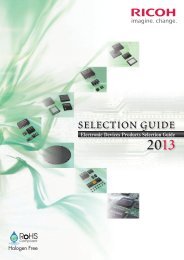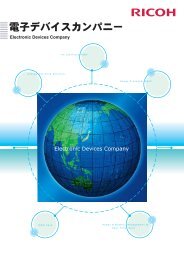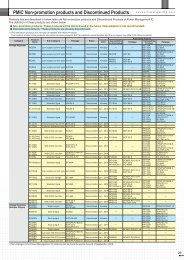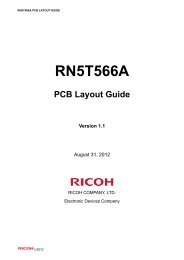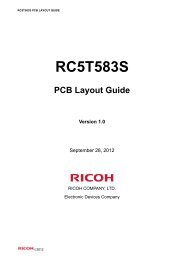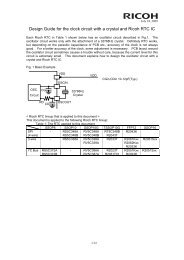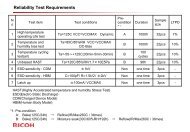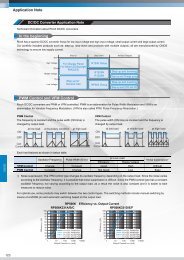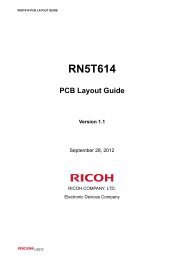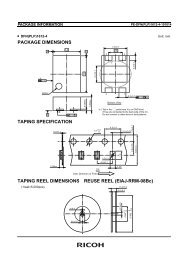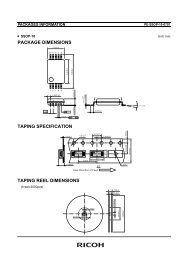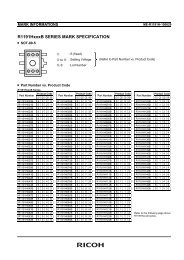Sustainable Environmental Management - Ricoh
Sustainable Environmental Management - Ricoh
Sustainable Environmental Management - Ricoh
You also want an ePaper? Increase the reach of your titles
YUMPU automatically turns print PDFs into web optimized ePapers that Google loves.
Top Message About us Our Activities<br />
Data<br />
<strong>Sustainable</strong> <strong>Environmental</strong> <strong>Management</strong><br />
Recyclable design<br />
■ Recyclable design front cover<br />
Incorporating the ease of recycling into<br />
product design<br />
Recyclable design is an essential approach to promoting resource<br />
conservation and product recycling. To introduce recyclable design, an<br />
organization that is now known as the Design for Environment Workshop<br />
was established in 1993. The workshop formulated the company’s first<br />
recyclable design policy based on the Comet Circle, and has built up<br />
know-how in various areas, such as the grading of plastic mould parts,<br />
strength design considering future reuse as well as the reduction of<br />
packaging materials, the reuse of high value-added parts, recycling of<br />
high-quality materials, and improvement in the ease of disassembling<br />
and sorting.<br />
After designing MFPs and printers, designers carry out recyclable<br />
design self-assessments to make necessary improvements, and in doing<br />
so, the consideration that designers impart to recycling has already<br />
become a part of their core design process.<br />
Comet Circle See page 62<br />
● Label positioned on<br />
one part<br />
It is more difficult to<br />
dismantle the unit if the label<br />
covers more than one part.<br />
● Compatible label<br />
Compatible labels do not have<br />
to be removed for recycling.<br />
● The spot on the cover where the<br />
product name decal (sticker) is<br />
attached<br />
By making a hole on the front cover at the<br />
spot where the product name label is<br />
attached, the label can be easily removed<br />
by inserting a screwdriver through the hole.<br />
Cover<br />
Decal<br />
Screwdriver<br />
● Surface of the outer cover<br />
The surface must be designed for easy<br />
cleaning and drying for recycling. The<br />
ditch on the covering and operation<br />
surfaces must be 2 mm or larger in width<br />
and 2 mm or smaller in depth with a<br />
bottom round with R0.5 mm or larger<br />
(except for figures and letter inscriptions).<br />
2 mm or<br />
smaller<br />
(depth)<br />
2 mm or larger<br />
(width of the ditch)<br />
R0.5 mm<br />
or larger<br />
Recycling technologies<br />
● Technology for forecasting used product<br />
collection volumes<br />
Making contributions to well-planned sales<br />
of recycled copiers<br />
<strong>Ricoh</strong> has developed a new technique for forecasting the volume of<br />
used products to be collected from the market. Given the nature of the<br />
products and the fact that recycled copiers are made from collected used<br />
copiers, an accurate collection volume forecast is particularly important<br />
to conduct this business in a well-planned manner. Using related data<br />
in our customer data base such as headcounts and numbers of copies<br />
printed, we prepare detailed forecasts, e.g., number of units, types of<br />
models, how many copies printed and which region they will be collected<br />
from, and during which period (monthly, semi-annually, annually). Such<br />
forecasts allow us to develop and implement plans on product design,<br />
development, production, and sales.<br />
■ Collection volume forecast<br />
Actual volume<br />
Forecast<br />
Accurate forecast even<br />
for large variance<br />
● Dry washing technology<br />
Stain removal without the use of water<br />
Recycling can never be labeled effective if it generates a significant<br />
impact on the environment. Based on this recognition, <strong>Ricoh</strong> has been<br />
making solid progress in developing resource-recirculating production<br />
systems. The development of original dry washing technology is among<br />
the latest examples of these systems.<br />
To recycle parts stained with toner, we previously employed an<br />
ultrasonic cleaning process that required the use of water, which<br />
inevitably involved wastewater treatment and energy consumption to dry<br />
the washed parts. With the newly developed technology, which cleans<br />
to a quality comparable to ultrasonic cleaning processes, toner stains<br />
are scraped off the parts by blasting them with tiny sheets of film, rather<br />
than water, at high speed. This new technology has been in practical use<br />
since 2007, mainly in the organic photoconductor unit cartridge recycling<br />
process both in Japan and overseas, and has led to considerably shorter<br />
operation times and less energy use than wastewater treatment and<br />
drying processes.<br />
Collection volume<br />
Residue<br />
Resin film<br />
Residue<br />
Resin film<br />
Residue<br />
collection<br />
port<br />
Discharge<br />
Removal of residue using resin film<br />
Separation and discharge of residue<br />
Period after product launch (months)<br />
For more details<br />
WEB www.ricoh.com/about/company/technology/tech/006.html<br />
<strong>Ricoh</strong> Group Sustainability Report 2012 68



